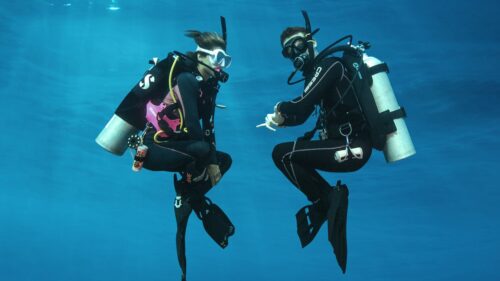The Art of Weightlessness: 5 Golden Keys to Mastering Buoyancy
Table of Contents
ToggleHave you ever seen a diver glide effortlessly past a coral reef, hovering motionless to capture the perfect photo, and wondered, “How do they do that?” The secret lies in a single skill: neutral buoyancy control. It is the hallmark of a good diver and a goal every diver should strive for.
Mastering buoyancy doesn’t just make you look cool; it completely transforms your entire diving experience. Join the experts at Amadive as we unveil the 5 golden keys to unlocking this “art of weightlessness.”

Why is Buoyancy Control So Important?
- Protect the Coral: It helps you avoid kicking, touching, or damaging fragile marine life.
- Conserve Air: When you’re not struggling to maintain your position, you breathe slower, and your dive lasts longer.
- Enhance Safety: It allows you to control your ascents and descents safely, avoiding risks associated with rapid depth changes.
- A Better Experience: Enjoy the true feeling of freedom as you hover and become one with the underwater environment.
The 5 Keys to Achieving Perfect Neutral Buoyancy
1. Perfect Your Weighting
This is the foundation for everything. Most new divers tend to be over-weighted, forcing them to constantly inflate and deflate their BCD.
- Why: Too much weight forces you to add more air to your BCD to compensate. This large bubble of air expands and contracts significantly with any depth change, making control very difficult.
- How: Perform a weight check at the start of a dive trip. With a nearly empty tank (about 50 bar / 500 psi) and an empty BCD, you should float at eye level while holding a normal breath. When you exhale, you should sink slowly.
2. Master Your Trim
Trim is your body’s posture in the water. The goal is a flat, horizontal, streamlined position, like a torpedo.
- Why: A horizontal position reduces drag, helping you move more efficiently. If your feet are sinking, you will constantly need to kick just to stay level.
- How: Adjust the position of weights on your belt or in your BCD’s weight pockets. Sometimes, moving a single weight from your hip to a trim pocket on your tank can make a huge difference. Keep your knees slightly bent and fins parallel to the seafloor.
3. Use Your Lungs as Your Natural BCD
This is your most important fine-tuning tool. Think of your BCD for big adjustments, and your breath for the small ones.
- Why: Your lungs can hold several liters of air. This change in volume directly affects your buoyancy.
- How: Once you are neutrally buoyant, try taking a slow, deep breath. You should feel yourself gently rise. When you fully exhale, you should slowly sink. Practice using your breath to control these minor changes in depth.
4. Use Your BCD Inflator/Deflator Sparingly
Many divers make the mistake of constantly pressing the buttons on their BCD.
- Why: This creates large, abrupt changes in buoyancy, leaving you constantly “chasing” your desired position.
- How: Only use your BCD for major depth changes. As you begin your descent, empty it completely. When you reach your target depth, add small bursts of air until you achieve neutral buoyancy. Then, put the inflator away and focus on using your breath.
5. Practice, Practice, Practice
Buoyancy is a skill that needs to be honed. Don’t be discouraged if you don’t master it immediately.
- Why: Every time you change your gear (e.g., wear a thicker wetsuit), your weighting and buoyancy will change.
- How: Dedicate the first few minutes of every dive to practice. Find a sandy patch and try drills like the “fin pivot.” The best way to accelerate your learning is by taking a specialty course like the PADI Peak Performance Buoyancy (PPB).
Mastering buoyancy is a journey, but every small improvement will pay huge dividends in your diving experience.
Want one-on-one guidance from our experts? Ask about our PADI Peak Performance Buoyancy course on your next trip to Con Dao!
PADI Scuba Diving Knowledge & Skills: The Complete Guide
Dive Safety & Truly Experience Diving in Con Dao with Amadive!
- Website: www.amadive.com.vn
- WhatsApp: +84 39 241 9241
- Email Reservation: book.amadive@gmail.com
